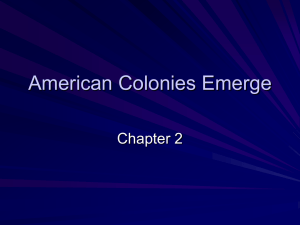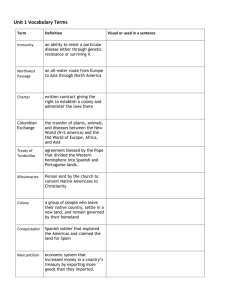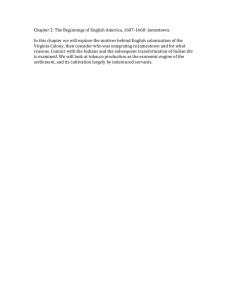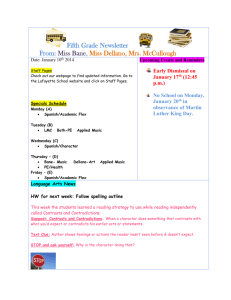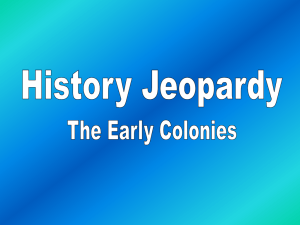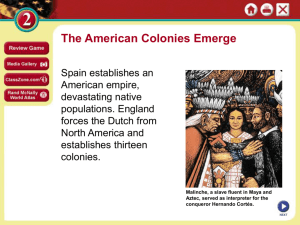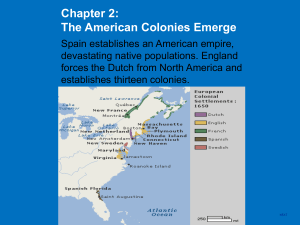Chapter 2 PPt
advertisement
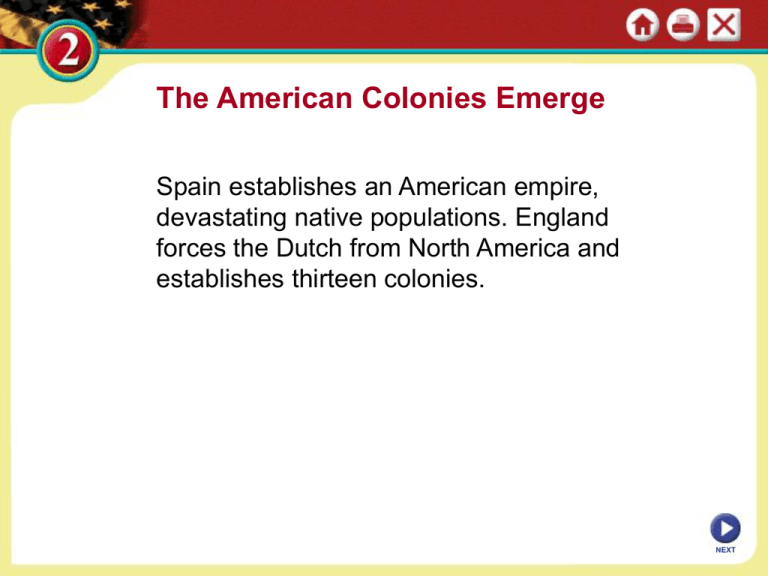
The American Colonies Emerge Spain establishes an American empire, devastating native populations. England forces the Dutch from North America and establishes thirteen colonies. NEXT The American Colonies Emerge SECTION 1 Spain’s Empire in the Americas SECTION 2 An English Settlement at Jamestown SECTION 3 Puritan New England SECTION 4 Settlement of the Middle Colonies NEXT Section 1 Spain’s Empire in the Americas Throughout the 1500s and 1600s, the Spanish conquer Central and portions of North America. NEXT SECTION 1 Spain’s Empire in the Americas The Spanish Claim a New Empire Cortés Subdues the Aztec • Conquistadors (conquerors)—Spanish explorers, seek gold, silver • 1519 Hernándo Cortés leads army into Americas, claims land for Spain • Aztec dominate region; Nahua people who resent Aztec join Cortés---NATIVE DISUNITY • Montezuma thinks Cortés a god; gives him share of Aztec gold • In 1520 Aztec rebel; in 1521 Spanish and their allies defeat Aztec • Cortés founds Mexico City, New Spain colony on Tenochtitlán ruins • Disease greatly reduces native populations of Continued . . . Aztecs, Mayans, Incas, and non-empire natives NEXT “This great city of Tenochtitlan is built on the salt lake, and no matter by what road you travel there are two leagues from the main body of the city to the mainland. There are four artificial causeways leading to it, and each is as wide as two cavalry lances.” SECTION 1 continued The Spanish Claim a New Empire Spanish Pattern of Conquest • Spanish settlers mostly men, called peninsulares; marry native women • Mestizo—person of mixed Spanish and Native American ancestry • Landlords use encomienda—force natives to farm, ranch, mine • Priests object, encomienda abolished; Africans brought as slaves NEXT The encomienda system SECTION 1 The Conquistadors Push North Other Countries Explore North America • England, France, Netherlands sponsor voyages in 1500s and 1600s Exploring Florida • Juan Ponce de León discovers and names La Florida (1513) • Pedro Menéndez de Avilés expels French, founds St. Augustine (1565) Settling the Southwest • In 1540, Francisco Vásquez de Coronado leads expedition to Southwest • Pedro de Peralta, governor of New Mexico, Spain’s northern holdings • He helps found Santa Fe (1609–1610); several missions built in area NEXT Fransisco Vasquera de Coronado was sent by the viceroy of Mexico, Antonio de Mendoza, to find the "Seven cities of Gold" and establish trade. In the early 1540s, Coronado set out with a few hundred men and natives in order to find these cities. Coronado in turn sent out several expeditions, led by Henando de Alverado that discovered the famous rock dwellings in the pueblo of Acoma and Lopez de Cardenas to the north and westward where they found what is now known as the Grand Canyon. Coronado found no gold but he did explore what is now known as the American Southwest. SECTION 1 Resistance to the Spanish Conflict in New Mexico • Priests convert many Native Americans, try to suppress their culture • In 1670s Spanish force natives to pay tribute, do labor for missions Popé’s Rebellion • Pueblo religious leader Popé heads uprising in New Mexico (1680) • Pueblo destroy Spanish churches, execute priests, force Spanish out • Spanish armies regain area 14 years later NEXT Pueblo Rebellion Having driven the Spanish from New Mexico, Popé tried to eradicate every possible vestige of their culture. He ordered the destruction of Christian objects and churches, punished the speaking of Spanish and the use of Spanish surnames, and argued against using Spanish tools such as the plow. In his style of leadership and exercise of personal power, however, Popé seems to have retained an element of Spanish authoritarianism which alienated many and contributed to the breakup of the Pueblo alliance. Section 2 An English Settlement at Jamestown The first permanent English settlement in North America is founded at Jamestown, Virginia, in 1607. NEXT SECTION 2 An English Settlement at Jamestown Reasons for English Exploration • Religious: Elizabeth backs the Reformation; rivalry with Spain over Christianity • Social: rich and poor both leave --Rich: nobility running out of land to give all of their sons --Poor: opportunity; new start • Economic: resources; joint-stock companies • Geopolitical: England vs. Spain; dominance of the seas, trade routes Continued . . . NEXT English Defeat of the Spanish Armada July 29, 1588: Off the coast of Gravelines, France, Spain's so-called "Invincible Armada" is defeated by an English naval force under the command of Lord Charles Howard and Sir Francis Drake. After eight hours of furious fighting, a change in wind direction prompted the Spanish to break off from the battle and retreat toward the North Sea. Its hopes of invasion crushed, the remnants of the Spanish Armada began a long and difficult journey back to Spain. The defeat of the Spanish Armada by the English fleet greatly reduced Spain’s naval presence in the world and thrust the English onto the world stage. English naval dominance made it possible for England to establish and expand its holdings in the New World. SECTION 2 An English Settlement at Jamestown English Settlers Struggle in North America The Business of Colonization • Joint-stock companies—investors fund colony, get profits • In 1607, Virginia Company sends 150 people to found Jamestown; the start of American history A Disastrous Start • Sir Walter Raleigh and Roanoke (1584) first attempt fails; second attempt—the Lost Colony • Colonists seek gold, suffer from disease and hunger; droughts/lack of crop cultivation • John Smith forces colonists to farm; gets help from Powhatan people • (1609) 600 colonists arrive; Powhatan destroy farms; “starving time” Continued . . . NEXT Above: Burial of the Jamestown dead during the "starving time," winter 1609-10 The winter of 1609 to 1610 was treacherous for early American settlers. Some 240 of the 300 colonists at Jamestown, in Virginia, died during this period, called the "Starving Time," when they were under siege and had no way to get food. Desperate times led to desperate measures. New evidence suggests that includes eating the flesh of fellow colonists who had already died. http://www.cnn.com/2013/05/01/us/jamestown-cannibalism/ SECTION 2 continued English Settlers Struggle in North America Jamestown Begins to Flourish • New arrivals revive and expand colony; John Rolfe (Pocahontas’) husband, grows tobacco “Brown Gold” and Indentured Servants • Tobacco becomes profitable; export 1.5 million pounds by late 1620s (mercantalism) • Virginia Company reforms --Headright system—purchaser of passage gets 50 acres—lures settlers --Develops representative government • Plantation owners use indentured servants— work 4–7 years for passage Continued . . . NEXT SECTION 2 continued English Settlers Struggle in North America The First African Laborers • First Africans arrive (1619); treated as indentured servants • After a few years, most receive land and freedom • Late 1600s, owners begin importing costly slaves because - indentured population decreases - colony becomes wealthy NEXT African Slaves in Jamestown The arrival of a ship in North America in the year 1619: Sails furled, flag drooping at her rounded stern, she rode the tide in from the sea. She was a strange ship, indeed, by all accounts, a frightening ship, a ship of mystery. Whether she was trader, privateer, or man-of-war no one knows. Through her bulwarks black-mouthed cannon yawned. The flag she flew was Dutch; her crew a motley. Her port of call, an English settlement, Jamestown, in the colony of Virginia. She came, she traded, and shortly afterwards was gone. Probably no ship in modern history has carried a more portentous freight. Her cargo? Twenty slaves. SECTION 2 The Settlers Clash with Native Americans The English Pattern of Conquest • Laws prevent English from living or intermarrying with Native Americans • English view the Natives like the viewed the Irish: “savages” The Settlers Battle Native Americans • Continued hostilities between Powhatan and English after starving time • 1614 marriage of Pocahontas and John Rolfe creates temporary peace • Renewed fighting; king makes Virginia royal colony under his control • By 1644, 10k Englishman live in VA; Powhatan populations fall NEXT Pocahontas The Virginia Company decided to bring Pocahontas to England in 1616 as a symbol of the tamed New World "savage" and the success of the Jamestown settlement. John Smith was living in London at the time and while Pocahontas was in Plymouth, she learned he was still alive. In March 1617, Rolfe and Pocahontas boarded a ship to return to Virginia when she fell ill. She was taken ashore and died in Rolfe’s arms, most likely from smallpox, pneumonia, or tuberculosis. SECTION 2 Economic Differences Split Virginia Hostilities Develop • Former indentured people settle frontier, cannot vote, pay high taxes • Frontier settlers battle natives; class tensions between frontier, wealthy • Governor Berkeley refuses to give money to help frontiersmen fight local natives Bacon’s Rebellion • Nathaniel Bacon raises army to fight natives on frontier (1676) • Bacon resents being taxed and governed without their consent; SOUND FAMILIAR? • Governor calls Bacon’s army illegal; Bacon sets fire to Jamestown; Bacon’s Rebellion represents a split between planters and frontiersmen NEXT Nathaniel Bacon confronts William Berkeley about attacking the Native Americans Burning of Jamestown Section 3 Puritan New England English Puritans come to North America, beginning in 1620. NEXT SECTION 3 Puritan New England Puritans Create a “New England” Puritans and Pilgrims • Puritans, religious group, want to purify Church of England • Believed Church of England didn’t go far enough to get rid of corrupt Catholic practices and leaders • Separatists, including Pilgrims, form independent congregations • In 1620, Pilgrims flee to escape persecution, found Plymouth Colony (2nd perm. English colony) • Diff. b/w VA & MA settlers’ intentions: VA was profitmotivated; MA was to create a model society The Massachusetts Bay Company • In 1630, joint-stock company founds Massachusetts Bay Colony • John Winthrop is Puritan colony’s first governor Continued . . . • Port city of Boston becomes their capital • 1000 men, women, and children within the first year NEXT SECTION 3 continued Puritans Create a “New England” “City Upon a Hill” • “For we must consider that we shall be as a City upon a Hill, the eyes of all people are on us” • Puritan adult males vote for General Court; Court chooses governor • However, no social or political equality Church and State • Civic officials are church members, have duty to do God’s will • Strong connection between church and state Importance of the Family • Puritans generally migrate as families, unlike in VA • Community makes sure family members behave in “God-fearing” way Continued . . . NEXT SECTION 3 Dissent in the Puritan Community The Founding of Providence • Roger Williams—extreme Separatist minister with controversial views --No right to take Native land --Gov’t had no right to punish people for religious beliefs • General Court orders his arrest; Williams flees • In 1636 he founds colony of Providence - negotiates for land with Narragansett tribe - guarantees separation of church and state, religious freedom Anne Hutchinson Banished • Anne Hutchinson teaches church, ministers are unnecessary; you can interpret the Bible yourself • Hutchinson banished 1638; family, followers leave colony NEXT SECTION 3 Native Americans Resist Colonial Expansion Disputes Over Land • Settlers spread to western Massachusetts, New Hampshire, Connecticut • Natives fear expansion of settlers will lead to an end of their way of life; fight over meaning of land ownership The Pequot War • Pequot War—Pequot takes stand against colonists in Connecticut; nearly destroys Pequot tribe; men, women, and children massacred King Philip’s War • Deprived of land, natives work for English, must follow Puritan laws • Wampanoag chief Metacom organizes tribes to wipe out settlers (1675); use guerilla tactics • King Philip’s War fierce; hunger, disease, immense casualties defeat tribes; Metacom killed NEXT King Philip’s War The war ended in August 1676, shortly after Metacom was captured and beheaded. Some of his supporters escaped to Canada; those who surrendered were shipped off as slaves to the West Indies. The Puritans interpreted their victory as a sign of God's favor, as well as a symbolic purge of their spiritual community. The Indians who remained faced servitude, disease, cultural disruption, and the expropriation of their lands. Section 4 Settlement of the Middle Colonies The Dutch settle New Netherland; English Quakers led by William Penn settle Pennsylvania. NEXT SECTION 4 Settlement of the Middle Colonies The Dutch Found New Netherland A Diverse Colony • In 1621, the Dutch West India Company colonizes New Netherland; granted permission by the Dutch government • Diversity: settlers from other European countries and Africa (free and enslaved) welcomed • Religious toleration • English—religion; for Dutch—it’s all about $$$ English Takeover • To the English, N. Netherland is a wedge b/w NE & VA • English ships arrive; Dutch governor Peter Stuyvesant tries to defend it; no one fought; no shots fired • In 1664, duke of York becomes proprietor (owner) of New Netherland - renames colony New York, later gives part of land to friends, names it New Jersey (overshadowed by NE and VA NEXT The Fall of New Amsterdam Peter Stuyvesant (left of center, with wooden leg) standing on shore among residents of New Amsterdam who are pleading with him not to open fire on the English who have arrived in warships waiting in the harbor to claim the territory for England. SECTION 4 The Quakers Settle Pennsylvania Penn’s “Holy Experiment” • In 1681, William Penn founds Pennsylvania on Quaker principles • Quakers ideas attract immigrants to settle: equality, cooperation, religious toleration, pacifism • Pennsylvania meant to be a “holy experiment” - adult males get 50 acres, right to vote - representative assembly - freedom of religion • Yet, Penn owns slaves • Penn treats native people fairly; over 50 years without conflict • Philadelphia (port city called “The City of Brotherly Love” by Penn) becomes the center of English colonial empire Continued . . . NEXT SECTION 4 continued The Quakers Settle Pennsylvania Thirteen Colonies • 1600s-1700s: other British colonies founded for varying reasons • Lord Baltimore, a Catholic, founds Maryland; has religious freedom • King Charles II awards key supporters land between VA and FLA; becomes NC and SC • James Ogelthorpe founds Georgia as haven for debtors --Drinking, slavery prohibited • By 1752, there are 13 British colonies in North America NEXT
